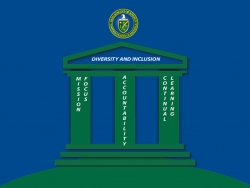
The Office of Diversity and Inclusion fosters a diverse and inclusive work environment that ensures equality of opportunity for applicants and employees through Departmental diversity policy development, workforce analysis, outreach, retention, and education. We seek to capitalize on the diverse attributes of the nation today to build an inclusive Energy Department for tomorrow. The Energy Department strives to be the Federal government’s model employer by leveraging diversity and inclusion to deliver the best public service on behalf of the nation.
Read our Policy Statement on Diversity and Inclusion
Our Work
The steps we are taking toward promoting our Department as a positive role model of equal opportunity, diversity, and inclusion are:
- Dialog and Feedback. The Department organized a series of focus groups to engage in a dialog on the diversity and inclusion climate at the Department and receive feedback. At the first-ever Department Diversity and Inclusion Town Hall, hosted by Secretary Chu and Associate Deputy Secretary Mel Williams, the Department discussed the results of focus groups, which engaged in a dialog on how diversity can be improved at DOE. You can download the Diversity and Inclusion Town Hall program booklet here, and view photos from the event here. Now, Diversity and Inclusion Town Halls are held across the complex on a regular basis to discuss issues on a site by site basis.
- Recruitment and Hiring. The Department reviewed our Human Capital policies and practices to (1) recommend appropriate changes to the Department’s recruitment and hiring practices and (2) ensure that all SES and supervisory level employees have an opportunity to participate in outreach efforts aimed at recruiting minorities and/or women.
- Retention, Development, and Promotions. We took action to ensure program leaders' efforts to redefine work and to restructure the workforce towards a more efficient and effective organization will not result in the unintended consequence of adversely affecting diversity and inclusion. Even in fiscally constrained periods, we must ensure that each individual has the opportunity for professional development and training towards enabling individuals to realize their full potential. We review each program’s practices, policies, and funding for professional development and training on an annual basis, and we support individual participation in training by affinity groups. The Department also reviewed our policies and practices regarding promotions for employees to ensure that they do not result in the unintended consequence of adversely affecting diversity and inclusion.
- Commitment and Understanding. We have developed an annual diversity events plan (internal observances and external outreach to communities and prospective hires) whereby senior leaders, managers, and employees may demonstrate their commitment to diversity via participation in diversity events, and receive the benefits of better understanding of our diverse workforce through personal involvement. We’ve also taken steps to upgrade our Continual Learning Program to include interactive case study discussions/training on how diversity and inclusion contribute to mission effectiveness, and ensure that all senior leaders participate in DOE diversity training programs at least once per fiscal year.
- Performance and Accountability. We have reviewed and changed (as needed) DOE performance appraisals and performance plans to ensure that all employees who have diversity responsibilities, and all senior leaders and managers are held accountable for performance results related to diversity, inclusion, and equal employment opportunity.
Questions? Get in touch with the Office of Diversity and Inclusion by emailing diversity@hq.doe.gov or contacting our staff.

